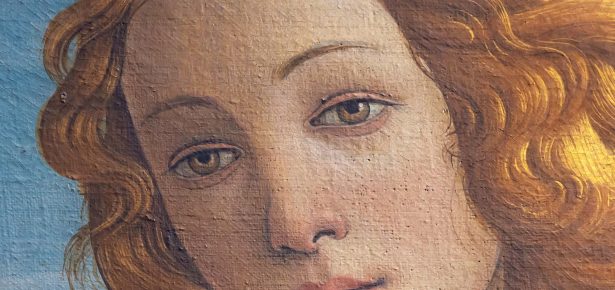
Sandro Botticelli’s Birth of Venus is a darling of the art world. The windblown goddess appears on calendars, magnets, aprons, and handbags. At Epcot (Disney Land Resorts), visitors can step inside the painting and pose as Venus – clothing is required! In addition to kitsch reproductions, the Birth of Venus has also inspired original works of art by Andy Warhol, Tomoko Nagao, and Chris Jordan. On March 22, 2014, the performance artist Adriàn Pino Olivera posed nude in front of the Uffizi painting in a staged act of rebirth. Shortly thereafter, he was arrested by Italian Carabinieri for indecent exposure!
Why is Botticelli’s Birth of Venus so alluring? This question along with many others related to beauty, desire, and sex forms the basis of my book Venus and the Arts of Love in Renaissance Florence. The book is an art historical survey of the goddess in the art, life, and governance of Florence between the fourteenth and sixteenth centuries. Organized chronologically, each of the six chapters investigates one of Venus’ divine attributes—her celestial splendor, rosy-hued complexion, enchanting fashions, green gardens, erotic anatomy, and gifts from the sea. Botticelli’s Birth of Venus is discussed in chapter 2, which investigates medieval and early modern understandings of skin and the demands placed on both women and artists to picture desirable flesh. I argue that Botticelli’s use of specific materials – such as alabaster, lead white, vermillion, red lake, and verdigris – contributes to the hypnotic beauty of his goddess. Similar substances, in fact, were used by fifteenth-century females to enhance their own complexions.
The Florentine artistic tradition of Venus; however, goes beyond Botticelli’s famous painting. Indeed, the artist depicted the goddess clothed more often than he did nude. His Primavera, Venus and Mars, and Venus and the Three Graces are the subject of two chapters in the book. Chapter 3 explores image-based magic and the enchanting power of clothing and adornment, while chapter 4 addresses the therapeutic powers of green spaces. Beyond scintillating starlight and beflowered garlands, Venus also patronized the erotic arts and a spectrum of sexual desires, which are explored in the fifth chapter dedicated to works by Michelangelo Buonarroti and Agnolo Bronzino. The goddess also served the political interests of Duke Cosimo I de’ Medici, symbolizing Florence’s newfound maritime interests and establishing the fecundity of the sea in the heart of the Arno River Valley.
In the course of deconstructing Venus’s trajectory in Florence, this book critically examines the physical materials and artistic techniques that evolved over time to fulfill and even enhance the goddess’s particular iconographic demands. The book posits that Florence’s artists skillfully manipulated materials in order to attract and delight individuals with the intention of stimulating desire—desire which often threatened to cross the line from appreciation and enthusiasm to something less chaste. Venus was both celebrated and censured for pleasuring Fiorenza, the city of flowers, where beauty and fertility were heavenly, but passion and power could be dangerous and sometimes deadly.
Latest Comments
Have your say!